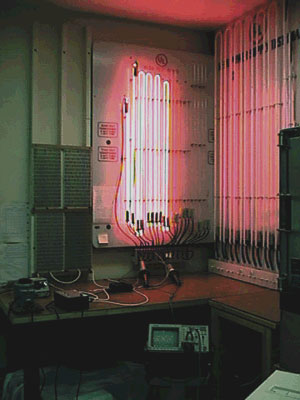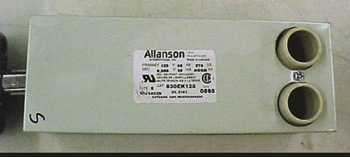All UL Listed signs and outline lighting which incorporate electric discharge tubing are required to use neon transformers and power supplies that comply with UL 2161, the Standard for Neon Transformers and Power Supplies. UL 2161 includes requirements for secondary ground fault protection (SGFP).
Previous Situation
Prior to September 3, 1999, gas tube sign transformers and power supplies were acceptable for use in UL Listed Signs and Outline Lighting. Gas tube sign transformers are evaluated for compliance with the Standard for Specialty Transformers, UL 506. Gas tube sign power supplies are evaluated for compliance with UL 506 and the Standard for Power Units Other Than Class 2, UL 1012. It should be noted that gas tube sign transformers and power supplies continue to be listed to the requirements of UL 506 and UL 1012 for applications other than signs. The requirements in UL 1012 were developed to evaluate constant voltage power supplies (power supplies used in computers, stereo equipment and the like) rather than constant current type gas tube sign power supplies. As the gas tube sign power supply industry developed and the use of these products in signs became more prominent, it became clear that a single UL safety standard covering both neon transformers and power supplies was needed.
Standard UL 2161
In 1993 UL initiated development of a new standard, UL 2161, to evaluate transformers and power supplies specifically intended for use with neon type circuits. During the three-year development cycle of UL 2161, SGFP in neon signs was proposed for the National Electrical Code (NEC) and was subsequently adopted.
The purpose of the SGFP requirements is to reduce the fire hazards associated with neon installations. In many cases, fires could be traced to improper installation methods. However, attempts to improve installation methods by education and other means were, for the most part, not successful. Therefore, SGFP was required in the NEC as a means to reduce the number of fires without relying on improved installation practices.
It is important to note that SGFP addresses a risk of fire and not a risk of electric shock. Injurious electric shock from neon circuits has not been reported as a field problem. The SGFP requirements are different when compared with ground-fault circuit interrupter (GFCI) requirements for line voltage circuits that are intended to address a risk of electric shock.
The development of UL 2161 has been a complex technical issue that included combining the requirements for transformers and power supplies into a single standard, significant upgrades in both the transformer and power supply requirements and the development of requirements for SGFP. Many of the revisions to the Standard did not involve SGFP but were related to including requirements to address new technology and adding new tests, test conditions and construction requirements to address the field reports.
SGFP also added a complex task to the development of the UL 2161 requirements. See Fig. 1. Even though SGFP was proposed and published in the NEC, manufacturers did not have a circuit that would perform even the most rudimentary function of secondary ground fault protection. Protective circuits were available, but they only protected the gas tube sign transformer or power supply and would not sense a ground fault under an assortment of conditions and shut off the output voltage. Therefore, minimum requirements had to be developed, tested by manufacturers in field conditions, and then adjustments made to the requirements until the SGFP requirements would accomplish the intended function while considering nuisance tripping. The result was UL 2161, an 86 page standard covering the construction and test requirements used to evaluate neon transformers and power supplies. It should be noted that in addition to the SGFP requirements, UL 2161 includes many significant upgrades in requirements over the requirements used to evaluate gas tube sign transformers and power supplies.
When requirements for SGFP were included in the 1996 NEC, technical details of the requirements such as trip current, trip time, testing to determine reliability, fault conditions under which the circuits should continue to function and many other technical details were not included in the NEC. These technical details had to be developed by the standards organization. To illustrate with an example, within ½ second of ground fault current reaching 15 mA, the SGFP circuitry is required to trip. The timing is very quick. However, some people believe the allowable fault current is high, which is not the case. Where a fault to ground involves an arc to ground (heat to increase the risk of fire), the arc will draw all of the available energy in the output circuit because the resistance of an arc is a conductance (the opposite of resistance). Also, the trip current cannot be too low because there are capacitive coupling currents that could be as high as 5 to 10 mA and nuisance tripping could result.

Figure 1. SGFP also added a complex task to the development of the UL 2161 requirements.
The SGFP requirements were developed with an emphasis on the SGFP circuit being reliable, not easily defeatable, and sensitive enough to react to reduce the risk of fire. The reliability of the circuits involves subjecting the circuitry to a number of possible field conditions such as failure of the SGFP components to function due to shorting or opening, thermal aging, over and under voltage conditions, power interruption, transient surges and humidity conditioning.
One of the most significant aspects of the requirements in UL 2161 is to require that the SGFP circuitry not be defeatable without a tremendous effort on the part of a user, manufacturer or installer. Test considerations include improper installation such as not providing an equipment ground, not providing a return conductor from the load when one is required and grounding of the load instead of providing a return conductor. Additionally, the SGFP circuit must be physically integral to the transformer or power supply, within the enclosure or wiring compartment and electrically connected such that no wiring connections except normal input and output connections of the transformer or power supply are accessible to the installer. These requirements make it very difficult to defeat the SGFP circuit. See Fig. 2.

Figure 2.
All these technical requirements are included in UL 2161. It should be noted that significant revisions and additions to the standard, which required re-testing of most products, were recently added to the Standard and became effective in September 1999.
Exceptions to SGFP in the NEC
During the development of UL 2161, it was determined during the early meetings that two types of transformers were much less likely to experience a secondary ground fault condition. A lack of field reports related to specific installation scenarios provided the basis to propose two exceptions for consideration in the NEC. These exceptions were included in the 1996 edition of the NEC.
One exception is for isolated output transformers with a maximum output voltage of 7500 volts. This exception is included because without a ground reference in the secondary circuit, the high voltage does not arc to ground. However, in UL 2161 this exception does not apply to neon power supplies with high output frequencies since high frequency couples readily to ground without a grounding connection within high frequency output neon power supplies.
The second exception is for neon transformers and power supplies with integral glass or porcelain electrode receptacles that require no field wiring of the secondary circuit. This exception was included because with a single continuous glass circuit, a break in the glass would result in the high voltage being available only at the transformer or power supply terminals. Therefore, a ground fault could occur only at the transformer or power supply terminals and the probability of a ground fault was significantly reduced. In a circuit with multiple glass segments, UL 2161 specifies that the interconnection of the tube segments must be accomplished by a Listed, More Than 1000-Volt Lampholder, without the use of GTO cable. These lampholders are constructed of glass or porcelain and, therefore, the probability of these insulating materials degrading to the point of permitting a ground fault at that location is significantly reduced. See Fig. 3, page 30.

Figure 3.
Components evaluated under these two exceptions to the NEC are covered under UL’s Component Recognition Service and are not UL Listed. They are required to bear the Recognized Component Mark.
They are covered under UL’s Component Recognition Service for use in UL Listed Signs and are not intended for use as field installed components. Component Recognition Service provides UL with the ability to oversee the use of these products to establish assurance that they will be used as intended and within their limitations. Since isolated output transformers were covered by UL under UL 2161 as Listed products prior to September 1999, Listed products of this type may still be available in the distribution channels.
Additional Exceptions to SGFP in UL 2161
When the SGFP requirements were first published in the NEC, UL 2161 was under development. The objective to achieve with the SGFP requirements was the reduction in the incidence of fires. The field report data suggested that most fires were occurring in installations in which the voltage to ground was 5 kV or greater in channel letters and border neon where 12 and 15 kV open circuit voltages were driving the neon. The typical currents for such applications were between 30 and 60 mA. In these applications the amount of energy available to a potential ground fault was significant. Additionally, at voltages below 5 kV to ground, the electrostatic field around high voltage conductors is small enough to not significantly degrade insulating materials, reducing the potential for ground faults to occur.
Subsequent to the deadline for proposals for the1996 edition of the NEC, it became apparent there were other types of products that were less likely to cause a risk of fire. The necessity of requiring dedicated SGFP circuitry in all transformers and power supplies came into question based on the field report data, limited output and use considerations. It was indicated that some products could be considered as inherently protected, and UL proposed requirements that would permit some transformers and power supplies without dedicated SGFP circuitry. Therefore, the following two additional exceptions to the requirement for specific SGFP circuitry were added to UL 2161 based on the determination that they were inherently protected.
1. Neon transformers and power supplies with a maximum output current of 15 mA between all output terminals or leads and from any output terminal or lead to ground.
2. Neon transformers with a maximum output current of 33 mA (30 mA + 10 %) between all output terminals or leads and from any output terminal or lead to ground and an output voltage to ground of less than 3001 volts at a frequency of 100 Hz or less. Neon power supplies with a maximum output current of 33 mA (30 mA + 10 %) between all output terminals or leads and from any output terminal or lead to ground and an output voltage to ground of less than 2001 volts at a frequency greater than 100 Hz.
Note to item 2. Although the field report data indicated that most problems were occurring in installations in which the voltage to ground was 5 kV or above, maximum voltage of 3 kV to ground was established as an additional margin of safety.
Since the deadline for proposals for the 1999 NEC coincided with the implementation of UL 2161, it appears that proposals to add these two exceptions were not submitted.
Transformers and power supplies intended for use with cold-cathode lighting systems and marked, “This product is for use in cold cathode lighting systems intended for installation in accordance with Article 410 of the NEC” also appear as an exception to the requirements for dedicated SGFP circuitry in UL 2161. This is because these lighting systems are only installed using lampholders over 1000 volts and Article 410 of the NEC covers cold-cathode lighting systems and does not require SGFP. These components are covered under UL’s Component Recognition Service and are not UL Listed. They are covered under UL’s Component Recognition Service for use in UL Listed Cold Cathode Lighting Systems. It is important to note that these transformers and power supplies are not intended for use in or with signs or outline lighting systems installed in accordance with Article 600 of the NEC. A neon transformer or power supply using cold cathode installed as outline lighting or as a sign is required to have SGFP protection.
Implementation of UL 2161
Implementing the requirements of UL 2161 was difficult and time consuming. Many transformer and power supply manufacturers produce hundreds of different models so the volume of work was large. The evaluation of these products is time and equipment intensive and stretched UL’s resources. Additionally, some of the requirements in UL 2161 were enhanced after manufacturers had completed Listing of their products. These products had to be revised to meet the enhanced requirements of UL 2161 and submitted again for evaluation. In addition, many of the early SGFP designs had significant nuisance tripping problems and had to be redesigned. The result of all of the implementation conditions has caused delays in making products available that comply with UL 2161.
Installation Considerations
If installers do not follow the proper spacing and wire routing requirements the installation may give the appearance of a secondary ground fault. Since such a condition will result in no perceived output from a neon transformer or power supply, the installers will be motivated to learn the proper installation practices. Additionally, those who do not use components and insulating materials in the manner intended will likely find the neon transformer or power supply will not provide an output because there is a ground fault.
Identification
Transformers and power supplies that comply with UL 2161 can be identified by the category name that is included as part of the Listing Mark. The category name will be either “Neon Transformer” or “Neon Power Supply.” Additionally, transformers and power supplies that were manufactured after September 3, 1999, will be marked, “Complies with Secondary Ground-Fault Protection Requirements of UL 2161.””
Transformers and power supplies evaluated by UL to the requirements of UL 506 or UL 1012 are not evaluated for compliance with SGFP requirements and are no longer acceptable for use in UL Listed Signs and Outline Lighting. However, these transformers and power supplies have applications other than signs, such as in copiers and amusement machines. Therefore, the requirements for gas tube sign transformers and power supplies in UL 506 and UL 1012 will not be withdrawn until 2002. This will provide time to develop requirements specifically for these products other applications. They can be identified by the category name “Gas Tube Sign Transformer” or “Gas Tube Sign Power Supply” that is included as part of the Listing Mark.
Summary
Although the requirements for SGFP have been in the NEC since 1996, their widespread usage is just now occurring with their required use in UL Listed Signs and Outline Lighting. With the implementation of these new transformers and power supplies, and recent upgrades in the requirements for GTO cable, the risk of fire in neon signs should be mitigated. It should also be noted that the 1996 NEC in Section 680-23(b) required transformers and electronic power supplies to have secondary ground-fault protection. The UL Standard 2161 still addresses this type of protection as secondary ground-fault protection, but adding the word “circuit”” was a change inserted into the 1999 NEC. In the 1999 NEC, in Section 600-23(b) the protection is now referred to as “secondary-circuit ground-fault protection (SCGFP), both in the title and the text.














Find Us on Socials